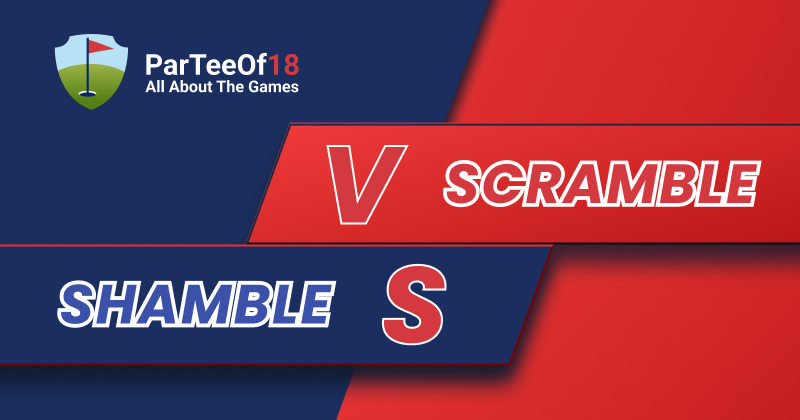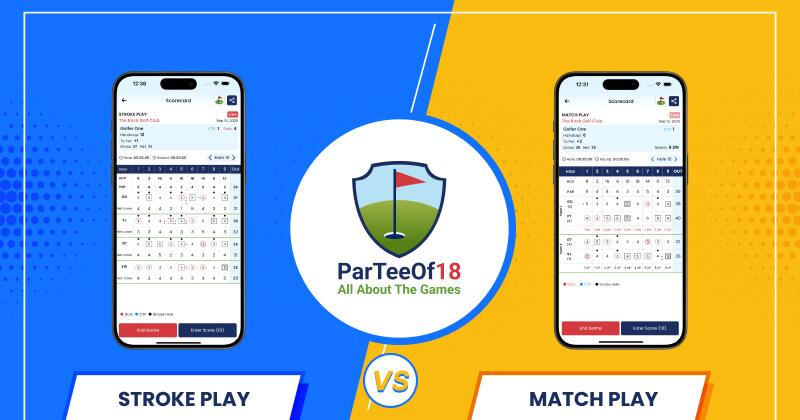Are you curious about the distinctions between the shamble and scramble golf formats? This simple guide provides you with the following benefit: “Shamble vs Scramble Explained—Which Format Is Better.” Many golfers and event organizers wonder which game style provides the most enjoyment, a fair environment, or a challenging format when playing golf. Both golf formats are often played during charity events, corporate tournaments, and friendly rounds, yet they have different rules for play and each offers its own benefits for fun play. In this blog, you’ll find an overview of shamble vs scramble, a clear breakdown of golf formats, and easy-to-understand explanations of the rules. You’ll learn the difference between a shamble and a scramble, as well as basic information and helpful hints on how to select a fun format for your next golf outing.
It doesn’t matter if you are new to golf or experienced; with knowledge of the two formats, you can decide which one to play based on your skill level, your goals, and the style of group you are playing in. Keep reading to see how the shamble and scramble formats keep golf fun, social, and accessible to all golfers who want to enjoy golf! You will learn in-depth information to help you decide which format is best for your next golf outing.
Shamble vs Scramble Overview
Golfers often compare Shamble vs Scramble formats to find which offers the right balance of fun and skill. At first glance, these two team games seem almost identical — both encourage teamwork, allow multiple players to contribute to each hole, and keep the pace of play brisk. However, the way each format handles shots and scoring creates very different experiences on the course.
In a Scramble, teamwork takes center stage — every player hits, and the group always plays from the best shot. It’s fast, forgiving, and perfect for friendly or charity rounds. A Shamble, on the other hand, blends that same teamwork with a stronger focus on individual performance. After selecting the best tee shot, each golfer plays their own ball into the hole, meaning every player’s skills truly count.
Understanding these Shamble vs Scramble differences helps golfers choose the right setup for their next event — whether they’re looking for a relaxed, social round or a slightly more competitive challenge.
Shamble vs Scramble Golf Format Comparison
Understanding how Shamble and Scramble differ starts with their overall structure and purpose. Both are team-oriented formats designed to keep the game fun and inclusive, but the way they balance teamwork and individual play makes them feel completely different.
In a Scramble, the focus is entirely on team collaboration. Every golfer hits a shot, the team picks the best one, and all players play their next shot from that spot. This continues until the ball is holed, making it a smooth, fast-moving game that minimizes pressure on weaker players. A Shamble Golf Format, however, introduces a mix of teamwork and personal skill. Like in a Scramble, everyone tees off and the team selects the best drive — but after that, each golfer plays their own ball until finishing the hole. The team score is then determined by the best (or sometimes top two) individual scores.
This subtle shift changes everything: the Shamble format rewards both strategy and consistency, while the Scramble rewards coordination and camaraderie. Golfers who enjoy a relaxed pace often favor Scrambles, while those wanting a bit more personal challenge tend to prefer Shambles.
Scramble vs Shamble Rules & How They Work?
Understanding the rules is key when comparing Shamble vs Scramble — not just how they start, but how scoring, shot strategy, and teamwork differ as the hole unfolds.
A Scramble thrives on teamwork. Most tournaments require that each player’s drive be used at least once or twice per round to keep participation fair. Some events even add “must-use” rules or restrict preferred lies on certain holes to increase challenge. A Shamble, on the other hand, keeps individual accountability alive. Once the team selects the best drive, everyone plays their own ball — and depending on the format, the team score might be the best individual score, or the average of the top two. This blend makes shambles popular for corporate and member events where skill balance matters.
Here’s a quick summary of how both formats function step by step:
| Step | Scramble | Shamble |
|---|---|---|
| Tee Shot | All hit, best selected | All hit, best selected |
| Next Shot | Team plays from the best shot each time | Each golfer plays their own ball from that spot |
| Scoring | Single team score — best shot counts | Best (or top two) individual scores form team total |
Pro Tip: In Scrambles, communication and shot placement matter most; in Shambles, consistent personal play after the drive is what separates winners from the rest.
Key Differences Between Shamble and Scramble Explained
Here’s where Shamble and Scramble truly separate in real play — not just in structure, but in how they feel and perform on the course:
- Teamwork vs Individual Skill: Scramble rewards group coordination — one great shot can save the team. Shamble challenges each golfer after the drive, making consistency more valuable than one lucky shot.
- Scoring Method: Scrambles record a single best team score per hole; Shambles blend individual play with team results, often using the best one or two scores. That small tweak increases competitive fairness.
- Pace of Play: Scrambles move faster since only one ball is tracked after every shot. Shambles take longer but let everyone stay engaged through the entire hole.
- Pressure Distribution: Scrambles reduce personal pressure — weaker players can rely on teammates. Shambles introduce mild tension since every golfer must finish their own ball.
- Handicap Impact: Scrambles typically adjust handicaps using team averages (e.g., 10–15% of combined index). Shambles allow individual handicaps to apply directly, creating more balanced scoring in mixed-skill groups.
Choosing the Right Format – Which One Fits Your Game
Deciding between a Shamble and a Scramble ultimately comes down to what kind of golfing experience you’re after. If you’re organizing a friendly or corporate outing, the goal is usually participation and pace — everyone should feel involved, even if they’re not strong players. That’s where the Scramble shines. It minimizes pressure, keeps play moving, and ensures weaker shots never hold the group back. But if you want a format that rewards both teamwork and individual skill, a Shamble offers more personal engagement after the tee shot.
For golfers seeking a bit more challenge or wanting to track their own performance, the Shamble is the better fit. It demands consistency and smart shot-making while still keeping the collaborative element alive. On the other hand, for beginners, social groups, or charity events where fun takes priority, the Scramble remains unbeatable. The best choice isn’t about which is superior — it’s about what suits your playing goals and the kind of experience you want from the round.
Conclusion
Both the Shamble and Scramble formats bring something unique to the course. Neither is strictly “better” — it all depends on what kind of round you want. If your goal is teamwork, inclusivity, and a relaxed pace, the Scramble format delivers every time. But if you enjoy balancing cooperation with personal accountability, the Shamble keeps things exciting by letting every player’s individual skill influence the outcome.
No matter which you choose, what matters most is how much fun you have and what you learn from each round. Try tracking your performance using a reliable golf scoring app or fine-tune your numbers with our golf handicap Estimator to see how each format shapes your game. After all, variety is what keeps golf fresh — and playing smarter is what makes every round more rewarding.
FAQs
What is the difference between Shamble and Scramble golf formats?
The main difference lies in how players continue after the tee shot. In a Scramble, the team always plays from the best shot until the hole is finished. In a Shamble, everyone tees off, picks the best drive, and then plays their own ball to the hole. The Shamble adds a personal performance layer to team play.
Can beginners play a Shamble or should they stick to a Scramble?
Beginners usually enjoy Scrambles more because they’re faster and forgiving — every player contributes without pressure on every shot. A Shamble suits golfers with some consistency who want to balance teamwork with individual skill.
How does scoring work in a Shamble compared to a Scramble?
In a Scramble, the team records one collective score per hole — the best result from the group. In a Shamble, scores are often taken from the best (or top two) individual players on each hole, creating a mix of team and personal accountability.
Does a Scramble or Shamble format help speed up pace of play more?
Scrambles are generally faster since the team plays only one ball after each shot. Shambles take slightly longer because every golfer plays their own ball after the drive, but they offer more individual shot-making opportunities.
How are handicaps applied differently in Shamble vs Scramble formats?
In Scrambles, handicaps are usually adjusted using a team formula (like a fraction of each player’s index). In Shambles, each player’s handicap is often applied individually, with only the best scores counting toward the team total. This keeps competition balanced across skill levels.



